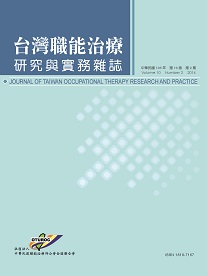Journal of Taiwan Occupational Therapy Research and Practice

半年刊,正常發行
目的:本研究之目的在使用低溫塑材為下肢嚴重痙攣腦中風患者設計一個降低張力減少內翻與垂足 (reducing inversion and foot drop, RID) 的踝足矯具,並初步測試比較穿戴RID踝足矯具與前葉式踝足矯具之差異。方法:RID 踝足矯具的製作是依據三點壓力系統、 踝足矯具可能降低張力的特點、國際義肢與矯具協會共識會議“最佳做法”的建議、痙攣抑制及改善足印壓力分布的技術及藉由踝關節背屈增加膝關節屈曲力距的理論。以平衡儀(Smart Balance Master System) 的感覺組合測驗 (Sensory Organization Test) 及三維動作分析系統進行姿勢穩定與步態之初步測試。結果:RID 踝足矯具的設計包括跟腱終端處施予壓力、維持距下關節及跟骨的結構位置與第一蹠骨處的減壓包覆以降低蹠屈及內翻張力。初步測試的結果顯示,穿戴 RID 踝足矯具相較前葉式踝足矯具站立姿勢較穩定,其壓力中心的移動軌跡長度較小(平均 41.96 cm vs 56.40 cm)、壓力中心移動的速度較小 ( 平均 13.49cm/sec vs 17.46 cm/sec)、靜態站立平衡總得分數較高 (81 vs 76)。此外,行走之速度 (29.00cm/sec vs 20.35cm/sec)、步長 (60.45cm vs 46.67cm)、步頻 (89steps/min vs 72steps/min) 皆表現較好。膝關節控制較佳,即患側腳在步態站立期 (stance phase)膝關節屈曲角度 (4.19° vs 8.70°) 接近正常人的 5°,並且站立期與擺動期比率 (1.52:1 vs 3.30:1) 亦較接近正常人的比率 (1.5:1)。結論:本研究考慮生物力學與神經生理等因素設計之 RID 踝足矯具,為處理下肢嚴重痙攣問題處方的踝足矯具提供另一種選擇。下肢嚴重痙攣腦中風患者穿戴 RID 踝足矯具在姿勢穩定及基本步態較前葉式踝足矯具表現佳, 而且在步態週期中有較佳的膝關節控制及站立/擺動比率。
Objectives: The purposes of this study were (1) to design a low temperature thermoplastic ankle foot orthosis (AFO) to reduce inversion tone and foot drop ( RID) in stroke patients with severe lower limb spasticity and (2) to preliminary investigate the effects of the RID AFO on static standing balance and gait in comparison with anterior AFO (AAFO). Methods: The design of the RID AFO was based on three-point pressure system, potential tone reduction features, “best practice” suggestion of the International Society for Prosthetics and Orthotics, spasticity inhibition and foot pressure distribution techniques, and increasing knee flexion moment via ankle dorsiflexion. The Sensory Organization Test of the Smart Balance aster System was used to quantify the center of pressure (COP) sway. The three- dimensional motion capture system was used for gait analysis. Results: The RID AFO was devised to apply pressure over Achilles tendon insertion area, aligning the subtalar joint and calcaneus in their neutral position and providing cover to the metatarsal heads to reduce excessive tone in plantarflexion and inversion. The results of the preliminary study showed that wearing RID AFO increased static stability by reducing COP sway trajectory (mean 41.96 cm vs 56.40 cm) and velocity (mean 13.49cm/sec vs 17.46 cm/sec) as well as increasing Sensory Organization Test (SOT) total score (81 vs 76) during SOT. The bene t was also shown in gait parameters, such as walking speed (29.00cm/sec vs 20.35cm/sec), step length (60.45cm vs 46.67 cm), and cadence (89 steps/min vs 72steps/min). During stance phase, the knee flexion of affected limb (4.19˚ vs 8.70˚ ) was approaching 5˚ of normal knee flexion. Additionally, the stance/swing ratio (1.52:1 vs 3.30:1) was near normal ratio (1.5:1). Conclusion: The RID AFO was designed by considering biomechanical and neurophysiological principles, as an alternative option for stroke patients with severe lower limb spasticity. Compared to AAFO, wearing the D AFO had greater positive effects on static standing balance, gait parameters, knee flexion control, and stance/swing ratio.












